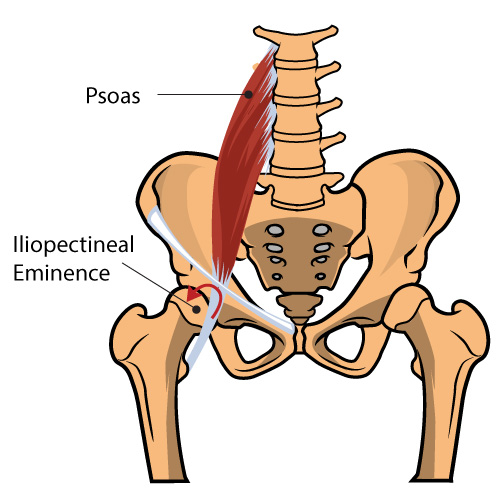Introduction
The iliopsoas tendon is a common source of hip pain in athletes who participate in resistance training, dance, jumping, rowing, track, and field, running, soccer, gymnastics, and hurdling.
The muscle originates on the lumbar spine and inside of the pelvic bowl. The tendon travels across the lower pelvis and attaches to the inner thigh. The largest bursa in the body, the iliopsoas bursa, is positioned between the muscle’s tendon and the pelvis.
When the muscle is excessively tight, its tendon may rub or even produce an audible snapping sound when passing over the underlying bone.
The iliopsoas tendon can be irritated by an acute injury or repetitive stress. Acute injuries typically result from either direct trauma or overwhelming contraction (like a kick) that overloads the tendon. Chronic injuries occur when repetitive stress exceeds the body’s ability to repair itself.
This condition is commonly termed “dancer’s hip” or “jumper’s hip”, as movements associated with these activities predispose these athletes to injury. Ongoing irritation may lead to an inflammatory reaction involving the tendon and/or underlying bursa. Chronic injury can lead to weakness or altered gait patterns.
Psoas tendinopathy is often associated with a variety of complaints, including difficulty standing fully erect, lower back pain, and possible radiation of discomfort into the buttock or thigh
Evaluation
‘There are a few common things that are observed right away when someone has a psoas tendon issue. The first is that they frequently feel most comfortable with their hip held up and turned out slightly. This shows us that the psoas muscle isn’t behaving the way we’d like it to. Related to this, people often have a forwardly tilted pelvis and increased curvature of the low back.
When we get into the actual exam tenderness of the muscle itself as well as around the femoral triangle is expected and can also be found at the tendon insertion in the groin area.
Stretching the hip backward, or into extension, is usually very difficult and often painful. This also goes for resisted hip flexion or bringing the knee up towards the head, especially when attempting this with force.
It’s common for us to find problems with weakness in the abductors, the foot, and spine. These areas of the body are associated with the same kinetic chain as the psoas and often need to be examined as well
Management
Psoas tendon pain can be managed conservatively in most cases. The unique 3 step process used by Twin Cities Movement starts by guiding you out of pain, then teaching you to rehab any underlying dysfunctional patterns, and last creating strength and resilience so you never have to worry about pain again.
Pain Elimination
The first step, in this case, is to take care of those tight muscles and restricted joints. We’re mostly going to be looking at the psoas, iliacus, hip capsule, lumbar spine, and pelvis.
We eliminate pain generally through resetting and protecting the injured tissue. An injury like this means chiropractic manipulation, Active Release Technique, instrument-assisted soft tissue mobilization, and potentially kinesiology tape.
Rehabilitation
Just like we talked about earlier. The other muscles involved in the kinetic chain need to be brought back to full health as well. This will more effectively keep this from becoming a recurrent or chronic issue. That means abductor and adductor muscles that are as strong and mobile as possible, a hip joint with full range of motion, and a foot that doesn’t overpronate.
Increasing Performance
Making sure that this injury doesn’t come back is the next most important thing. We do this by making that tendon and associated structures that we’ve mentioned before as strong as possible. This usually starts with simple movements like bridges, monster walks, leg lifts, etc., and moves on up to more advanced single-leg exercises like rear foot elevated split squats and single-leg broad jumps. This is an ongoing process but by far the most valuable thing you can continue to do.

